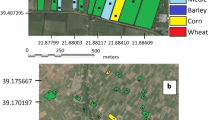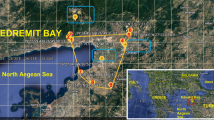Abstract
The citrus leafminer (CLM) Phyllocnistis citrella Stainton (Lepidoptera; Gracillariidae) is an important citrus pest. The population dynamic was monitored to assess the infestation state during summer-autumn seasons in a citrus-growing area of Algeria (Mitidja). The densities were estimated using immature stages sampling and male moth catches in pheromone-baited traps. The analysis of both methods showed that the presence of the CLM did not differ significantly between years but differs significantly between months. The monitoring of the population revealed that the incidence of this pest has considerably decreased compared to its first introduction in the area. The insect has developed 4 generations for both years considered; 2 in summer and another 2 in autumn. The mean density of CLM per leaf recorded was 1.42 in 2017 and 1.24 in 2018. The number of moth caught in pheromone-baited traps showed an important density and was predictive for the immature stages’ population. No significant relationship was found between moth catches and larval densities during the successive years studied. However, a significant relationship was found between larval densities and infested flushes on one hand, and on the other hand, between total flushes density and flushes infested. The moths catches using pheromone-baited traps could present a complementary variability source to help measure population and predict infestations. However, they do not necessarily reflect the actual immature stages densities.



Similar content being viewed by others
Availability of data and material
Not applicable.
Abbreviations
- ANOVA:
-
Analysis of variance
- CLM:
-
Citrus leafminer
- I/L:
-
Individuals per leaf
References
Ahmed S, Khan MA, Hassan B, Haider H, Ahmad SF (2013) Studies on citrus leafminer (CLM) in relation to abiotic factors on different host plants in Punjab. Pakistan Pak Entomol 35(1):5–10
Berkani A (1995) Apparition en Algérie de Phyllocnistis citrella Stainton, chenille mineuse nuisible aux agrumes. Fruits 50(5):347–352
Berkani A (2000) Durée de dévelopmment pré-imaginal et mortalité de Phyllocnistis citrella (Lepidoptera, Gracillariidae) en conditions semi-controlées en Algérie. Fruits 55(5):303–308
Berkani A, Mouats A (1998) Note technique : Vers une lutte biologique de Phyllocnistis citrella par introduction d’Ageniaspis citricola en vergers d’agrumes dans l’Ouest algérien. Fruits 53(2):99–103
Berkani A, Mouats A, Dridi B (1996) Observations sur la dynamique des populations de Phyllocnistis citrella Stainton (Lepidoptera : Gracillariidae) en Algérie. Fruits 51(6):417–424
Boualem M, Villemant C, Berkani A (2007) Présence en Algérie de trois nouveaux parasitoïdes ( Hymenoptera, Eulophidae ) de la Mineuse des agrumes, Phyllocnistis citrella. Bulletin De La Société Entomologique De France 112(3):381–386
Braham M, Chermiti B, Souissi R, Znaidi M (2006) Establishment and dispersal of the parasitoids Ageniaspis citricola Logvinovskaya (Hymenoptera: Encyrtidae) and Semielacher petiolatus Girault (Hymenoptera: Eulophidae), introduced into Tunisia for the biological control of Phyllocnistis citrella (Lepidop. International Journal of Pest Management 52(4):353–363. https://doi.org/10.1080/09670870600914259
Caleca V, Lo Verde G, Blando S, Lo Verde V (1998) New data on the parasitism of citrus leafminer (Phyllocnistis citrella Stainton, Lep. Gracillariidae) in Sicily. Bollettino Zoologia Agraria e Bachicoltura Ser 30
Dahmane M, Chakali G (2020) Distribution pattern of developmental stages of Phyllocnistis citrella Stainton (Lepidoptera: Gracillariidae) on the surface of citrus leaves. Polish Journal of Entomology 1(89):1–6. https://doi.org/10.5604/01.3001.0014.0230
Diez PA, Peña JE, Fidalgo P (2006) population dynamics of phyllocnistis citrella (Lepidoptera : gracillariidae) and its parasitoids in Ttafí viejo, Tucumán. Argentina Florida Entomological Society 89(3):328–335
Elekcioǧlu NZ, Uygun N (2013) Population fluctuation of citrus leafminer, Phyllocnistis citrella Stainton (Lepidoptera: Gracillariidae) and its parasitoids in the eastern Mediterranean region of Turkey. Pak J Zool 45(5):1393–1403
Garcia-Marí F, Costa-Comelles J, Vercher R, Granda C (1997) El minador de hojas de cítricos: Presente y futuro de una plaga importada. Phytoma España 92:94–102
Garcia-Marí F, Granda C, Zaragoza S, Agustí M (2002) Impact of Phyllocnistis citrella (Lepidoptera: Gracillariidae) on leaf area development and yield of mature citrus trees in the Mediterranean area. J Econ Entomol 95(5):966–974. https://doi.org/10.1093/jee/95.5.966
Grafton-Cardwell EE, Morse JG, O’Connell NV, Phillips PA, Kallsen CE, Haviland DR (2012) Insects, mites and snails. In Integrated Pest Management Program, Agricultural and Natural Resources (Integrated, 3303). University of California
Graham JH, Gottwald TR, Cubero J, Achor DS (2004) Xanthomonas axonopodis pv . citri : factors affecting successful. Mole Plant Pathol 5(1):1–15. https://doi.org/10.1046/J.1364-3703.2003.00197.X
Greve C, Redaelli LR (2006) Variação sazonal dos estágios imaturos de Phyllocnistis citrella Stainton (Lepidoptera: Gracillariidae) em pomares de Citrus sinensis sob dois sistemas de cultivo. Neotrop Entomol 35(6):828–833. https://doi.org/10.1590/S1519-566X2006000600005
Hall DG, Albrigo LG (2007) Estimating the relative abundance of flush shoots in citrus with implications on monitoring insects associated with flush. HortScience 42(2):364–368. https://doi.org/10.21273/hortsci.42.2.364
Heppner JB (1993) Citrus leafminer, Phyllocnistis citrella, in Florida (Lepidoptera: Gracillariidae: Phyllocnistinae). Tropical Lepidoptera 4(1):49–64
Hillier NK, Dixon PL, Larson DJ (2004) Trap captures of male Grapholita libertina (lepidoptera: Tortricidae) moths: Relationship to larval numbers and damage in wild lingonberry1. Environ Entomol 33(2):405–417
Howse PE, Stevens IDR, Jones OT (1998) Mating disruption. In: Insect pheromones and their use in pest management. Springer, Dordrecht, pp 314–344
Hoy MA, Singh R, Rogers ME (2007) Citrus leafminer, Phyllocnistis citrella (Lepidoptera : Gracillariidae ), and natural enemy dynamics in central florida during 2005. Florida Entomologist 90(2):358–369
Jesus CRD, Redaelli LR, Dal Soglio FK (2008) Flutuação populacional de Phyllocnistis citrella Stainton em Citrus deliciosa e no híbrido Murcott Citrus sinensis x Citrus reticulata. Ciencia Rural 38(3):593–600. https://doi.org/10.1590/S0103-84782008000300001
Kheder SB, Jerraya A, Jrad F, Fezzani M (2002) Étude de la mineuse des agrumes Phyllocnistis citrella Stainton (Lep. Gracillariidae) dans la région du Cap Bon (Tunisie). Fruits 57(1):29–42. https://doi.org/10.1051/fruits:2002004
Knapp JL (1995) Citrus leafminer, Phyllocnistis citrella Stainton: current status in Florida. University of Florida
Lapointe SL, Leal WS (2007) Describing Seasonal Phenology of the Leafminer Phyllocnistis citrella ( Lepidoptera : Gracillariidae ) with Pheromone Lures : Controlling for Lure Degradation. Florida Entomologist 90(4):710–714
Legaspi JC, French JV, Schauff ME, Woolley JB (1999) The citrus leafminer Phyllocnistis citrella (Lepidoptera: Gracillariidae)in South Texas: Incidence and parasitism. Florida Entomologist 82(2):305–316. https://doi.org/10.2307/3496584
Liebhold AM, Elkinton JS, Zhou G, Hohn ME, Rossi RE, Boettneh GH, Boettneh CW, Burnham M, Mcmanus ML (1995) Regional Correlation of Gypsy Moth (Lepidoptera: Lyn1antriidae) Defoliation with Cormts of Egg Masses, Pupae, and Male Moths. Environ Entomol 24(2):193–203
Lo Pinto M, Fucarino A (2000) Osservazioni biologiche su Phyllocnistis citrella in Sicilia. Informatore Fitopatologico 3:54–60
Mafi SA, Le VV, Nakata Y, Ohbayashi N, Yamamoto M, Ando T (2005) Identification of the sex pheromone of the citrus leafminer ( Phyllocnistis citrella Stainton, Lepidoptera : Gracillariidae ) with a trial of control by the communication disruption method. J Pestic Sci 30(4):361–367
Mansour D, Pérez-Hedo M, Catalán J, Karamaouna F, Braham M, Jaques JA, Urbaneja A (2021) Biological control of the citrus leafminer 25 years after its introduction in the Valencia citrus growing area (Spain): A new player in the game. Biological Control 155(November 2020). https://doi.org/10.1016/j.biocontrol.2020.104529
Peña JE, Duncan R, Browning H (1996) Seasonal Abundance of Phyllocnistis citrella. Biol Control 25(3):1993–1995
Peña JE, Hunsberger A, Schaffer B (2000) Citrus leafminer (Lepidoptera: Gracillariidae) density: effect on yield of ‘Tahiti’lime. J Econ Entomol 93(2):374–379
Quilici S, Franck A, Vincenot D, Montagneux B, Pastou D (1996) First studies on the Citrus leaf-miner Phyllocnistis citrella (Stainton)(Lepidoptera: Gracillariidae) in Reunion island. ISC. https://agritrop.cirad.fr/388911/
Saharaoui L, Benzara A, Doumandji-mitiche B (2001) Note technique Dynamique des populations de Phyllocnistis citrella Stainton (1856) et impact de son complexe parasitaire en Algérie. Fruits 56(6):403–413
Salhi N, Doumandji-Mitiche B (2009) Population dynamics of the citrus leaf miner, Phyllocnistis citrella (Lepidoptera: Gracillariidae) and its parasitoids on marsh seedless grapefruit in Algeria. Journal of the Entomological Research Society 11(1):5–16
Sappington TW, Spurgeon DW (2000) Variation in boll weevil (Coleoptera: Curculionidae) captures in pheromone traps arising from wind speed moderation by brush lines. Environ Entomol 29(4):807–814. https://doi.org/10.1603/0046-225X-29.4.807
Smith D, Beattie GA, Broadley R (1997) Citrus pests and their natural enemies: integrated pest management in Australia. Queensland. Department of Primary Industries. http://hdl.handle.net/10462/pdf/9446
Stelinski LL, Rogers ME (2008) Factors affecting captures of male citrus leafminer, Phyllocnistis citrella Stainton, in pheromone-baited traps. J Appl Entomol. https://doi.org/10.1111/j.1439-0418.2007.01258.x
Tutiempo (2022) Données climatiques. https://fr.tutiempo.net/climat/ws-603690.html
Urbaneja A, Llacer E, Tomas O, Garrido A, Jacas JA (2000) Indigenous Natural Enemies Associated with Phyllocnistis citrella ( Lepidoptera : Gracillariidae ) in Eastern Spain. Biol Control 207(18):199–207. https://doi.org/10.1006/bcon.2000.0830
Vanaclocha P, Jones MM, Monzó C, Stansly PA (2016) Placement Density and Longevity of Pheromone Traps for Monitoring of the Citrus Leafminer (Lepidoptera: Gracillariidae). Florida Entomologist 99(2):196–202. https://doi.org/10.1653/024.099.0207
Wang L, Bisseleua DH, You M, Huang J, Liu B (2006) Population dynamics and functional response of Citrostichus phyllocnistoides (Narayanan) (Hym.,Eulophidae) on citrus leaf-miner, Phyllocnistis citrella Stainton (Lep., Phyllocnistidae) in Fuzhou region of south-east China. J Appl Entomol 130(2):96–102. https://doi.org/10.1111/j.1439-0418.2005.01022.x
Witzgall P, Kirsch P, Cork A (2010) Sex pheromones and their impact on pest management. J Chem Ecol 36(1):80–100. https://doi.org/10.1007/s10886-009-9737-y
Acknowledgements
Not applicable.
Funding
No funding was received for conducting this study.
Author information
Authors and Affiliations
Contributions
MD carried out the experiment, the statistical analysis, interpretation of the data and was a major contributor in writing the manuscript. GC supervised the work and revised the manuscript. The author(s) read and approved the final manuscript.
Corresponding author
Ethics declarations
Ethics approval and consent to participate
Not applicable.
Consent for publication
The authors agreed to publish this paper. The data have not been published partially or completely in any other journal.
Competing interests
The authors have no conflicts of interest to declare that are relevant to the content of this article.
Additional information
Publisher's Note
Springer Nature remains neutral with regard to jurisdictional claims in published maps and institutional affiliations.
Rights and permissions
About this article
Cite this article
Dahmane, M., Chakali, G. Population dynamic monitoring of Phyllocnistis citrella (Lepidoptera: Gracillariidae) using immature stages sampling and male moth pheromone-baited traps. Int J Trop Insect Sci 42, 3107–3113 (2022). https://doi.org/10.1007/s42690-022-00853-z
Received:
Accepted:
Published:
Issue Date:
DOI: https://doi.org/10.1007/s42690-022-00853-z




